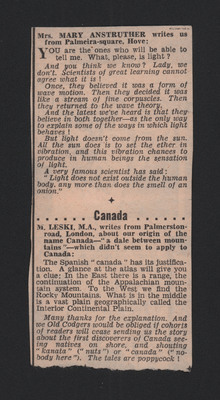Readers Letters
Title
Readers Letters
Description
One newspaper cutting with two readers letters, the first about light and the second about the origin of the name for Canada.
Coverage
Language
Type
Format
One newspaper cutting
Publisher
Rights
This content is available under a CC BY-NC 4.0 International license (Creative Commons Attribution-NonCommercial 4.0). It has been published ‘as is’ and may contain inaccuracies or culturally inappropriate references that do not necessarily reflect the official policy or position of the University of Lincoln or the International Bomber Command Centre. For more information, visit https://creativecommons.org/licenses/by-nc/4.0/ and https://ibccdigitalarchive.lincoln.ac.uk/omeka/legal.
Contributor
Identifier
SMcDermottC1119618v10005
Transcription
Mrs. MARY ANSTRUTHER writes us from Palmeira-square, Hove:
YOU are the ones who will be able to tell me. What, please, is light?
And you think we know? Lady, we don’t. Scientists of great learning cannot agree what it is!
Once, they believed it was a form of wave motion. Then they decided it was like a stream of fine corpuscles. Then they returned to the wave theory.
And the latest we’ve heard is that they believe in both together – as the only way to explain some of the ways in which light behaves!
But light doesn’t come from the sun. All the sun does is to set the ether in vibration, and this vibration chances to produce in human beings the sensation of light.
A very famous scientist has said:
“Light does not exist outside the human body, any more than does the smell of an onion.”
[symbol]
. . . . . . Canada . . . . . .
M. LESKI, M.A., writes from Palmerston-road, London, about our origin of the name Canada – “a dale between mountains” – which didn’t seem to apply to Canada:
The Spanish “canada” has its justification. A glance at the atlas will give you a clue: In the East there is a range, the continuation of the Appalachian mountain system. To the West we find the Rocky Mountains. What is in the middle is a vast plain geographically called the Interior Continental Plain.
Many thanks for the explanation. And we Old Codgers would be obliged if cohorts of readers will cease sending us the story about the first discoverers of Canada seeing natives on shore, and shouting “kanata” (“nuts”) or “canada” (“nobody here”). The tales are poppycock!
YOU are the ones who will be able to tell me. What, please, is light?
And you think we know? Lady, we don’t. Scientists of great learning cannot agree what it is!
Once, they believed it was a form of wave motion. Then they decided it was like a stream of fine corpuscles. Then they returned to the wave theory.
And the latest we’ve heard is that they believe in both together – as the only way to explain some of the ways in which light behaves!
But light doesn’t come from the sun. All the sun does is to set the ether in vibration, and this vibration chances to produce in human beings the sensation of light.
A very famous scientist has said:
“Light does not exist outside the human body, any more than does the smell of an onion.”
[symbol]
. . . . . . Canada . . . . . .
M. LESKI, M.A., writes from Palmerston-road, London, about our origin of the name Canada – “a dale between mountains” – which didn’t seem to apply to Canada:
The Spanish “canada” has its justification. A glance at the atlas will give you a clue: In the East there is a range, the continuation of the Appalachian mountain system. To the West we find the Rocky Mountains. What is in the middle is a vast plain geographically called the Interior Continental Plain.
Many thanks for the explanation. And we Old Codgers would be obliged if cohorts of readers will cease sending us the story about the first discoverers of Canada seeing natives on shore, and shouting “kanata” (“nuts”) or “canada” (“nobody here”). The tales are poppycock!
Collection
Citation
“Readers Letters,” IBCC Digital Archive, accessed November 5, 2024, https://ibccdigitalarchive.lincoln.ac.uk/omeka/collections/document/27648.
Item Relations
This item has no relations.

